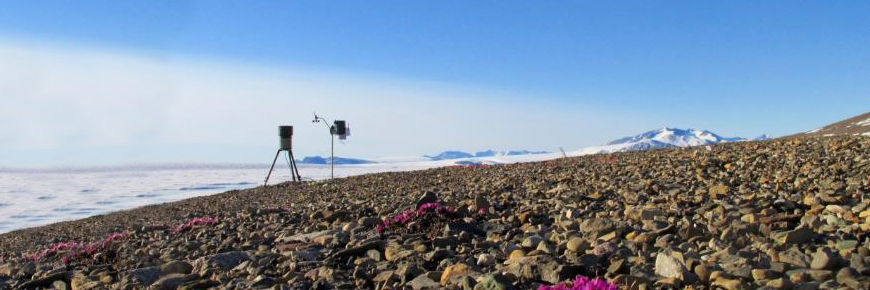
Photo: Catherine Girard
Northern Ellesmere Island in the global environment, led by Dr. Warwick Vincent
Quttinirpaaq National Park
This team has been studying the impact of climate change on Northern Ellesmere Island for many years, including in the north of Quttinirpaaq National Park since 1998. They have been gathering information on the weather, ice shelves, lakes, fjords and glaciers of the area, including on the microorganisms that live there.
Methods
There were six aspects to this research project in 2018:
Environmental monitoring
Long-term measurements continue to be taken from climate stations, permafrost monitoring and automated cameras on Ward Hunt Island. These data are available to all stakeholders including northern communities by publication in the online, open access data report series Nordicana D. Another one-year record of lake temperatures and underwater light at Ward Hunt Lake were also retrieved, and the instruments were reinstalled for retrieval next year. New high resolution automated camera data at Ward Hunt Lake was downloaded to track the changes in ice cover more precisely.
Lake profiling
Measurements continued for tracking water column change, with a profiling of Ward Hunt Lake. These data are also being made available through Nordicana D.
Microbiological research
This summer, ongoing progress was made with high resolution sampling of Ward Hunt Island Lake and Thores Lake. Sampling was carried out for viruses, other microbes, pigments and a wide range of physical and chemical measurements. It is anticipated that these data will provide a baseline from which to study future change in these sensitive environments.
Air sampling
This summer, aerosol samples were collected by concentrating large volumes of air onto filters. Samples were collected across Ward Hunt Island and on the Ward Hunt ice rise, as well as at Thores Lake and Thores Glacier. It is expected that the analysis of these samples will describe the viruses and microbes in the atmosphere for these environments. This type of research has never been conducted in the Arctic, and it is expected that the results will provide unique information on the connectivity of microbial habitats in the North.
Ice sampling
Ice cores were collected at Ward Hunt and Thores Lake to assess the microbial populations of frozen freshwater environments. Ice was collected from the surface at the air-ice interface (to understand microbial contributions from the atmosphere) and from the bottom at the ice-water interface (to understand microbial exchanges between the ice and water column). Ice cores were also collected at a depth of 30cm at Thores Glacier, to describe the surface microbes this glacier may be contributing to downstream environments through its thawing.
Water and sediment sampling
A successful sampling trip to the Stuckberry Point lakes was carried out and obtained sediment cores and water samples from four lakes, as planned.
Discussion and results
All samples are currently being analysed. The team would like to return in May-August 2019 to continue each of these projects, with the possibility of a return visit to Thores Lake (82.65N; 73.68W), a long proglacial lake near Disraeli Fiord. A new paper has been produced on the microbial ecology of Ward Hunt Lake by the team.
Research partners
Principal researchers:
Dr. Warwick F. Vincent, Département de biologie & Centre d’études nordiques, Université Laval
Dr. Alexander Culley, Département de microbiologie & Centre d’études nordiques, Université Laval
Dr. Dermot Antoniades, Département de géographie & Centre d’études nordiques, Université Laval
Field research team:
Dermot Antoniades, Département de géographie & Centre d’Études Nordiques, Université Laval
Alexander Culley, Département de microbiologie, Université Laval
Catherine Girard, Département de microbiologie, Université Laval
Elise Imbeau, Département des sciences fondamentales, Université du Québec à Chicoutimi
Yohanna Klanten, Département de géographie & Centre d’Études Nordiques, Université Laval
Catherine Marois, Département de microbiologie & Centre d’Études Nordiques, Université Laval
Katherine Triglav, Département de géographie & Centre d’études nordiques, Université Laval
Denis Sarrazin, Centre d’Études Nordiques, Université Laval
Yukiko Tanabe, National Institute of Polar Research, Tokyo, Japan
For more information on Dr. Warwick Vincent’s research, you can read this Parks Canada profile; articles on climate station data, water column profiles, and phytoplankton pigments at the open access data report series Nordicana D; and this article from Frontiers in Microbiology.
The recently released Integrated Regional Impact Study (IRIS) on the Eastern Arctic includes a chapter on the state of freshwater and glacier environments in that region. The report includes information on the studies conducted by the team mentioned above.
- Date modified :